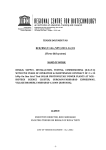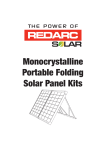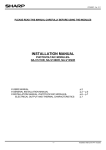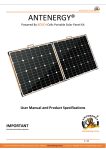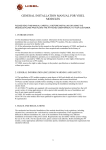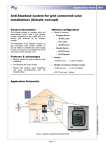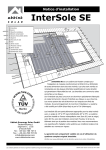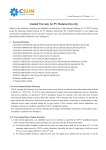Download SEIAPI PPA install grid connect guidelines
Transcript
SEIAPI PPA Install Grid Connect Guidelines Suva Workshop 27th-29th August 2014 STANDARDS FOR INSTALLATION GRID-CONNECTED POWER SYSTEMS SYSTEM INSTALLATION GUIDELINES In Australia and New Zealand the following standards are applicable: … AS/NZS 3000 AS 4777.1 AS/NZS 5033 AS/NZS 1768 AS/NZS 4509 AS/NZS 3008 AS/NZS 1170.2 Wiring Rules Grid connect - Installation Installation of Photovoltaic (PV) Arrays Lightning Protection Stand-alone Power Systems Selection of cables Wind Loads STANDARDS FOR INSTALLATION 2 In USA PV systems must be in accordance with following codes and standards: • Electrical Codes-National Electrical Code Article 690:Solar Photovoltaic Systems and NFPA 70 Uniform Solar Energy Code • Building Codes- ICC, ASCE 7 • UL Standard 1701; Flat Plat Photovoltaic Modules and Panels • IEEE 1547, Standards for Interconnecting distributed Resources with Electric Power Systems • UL Standard 1741 , Standard for Inverter, converters, Controllers and Interconnection System Equipment for use with Distributed Energy Resources LV vs ELV • In the Australian standards Low Voltage (LV) is defined as 120V d.c. and above and Extra Low Voltage (ELV) is defined as below 120V d.c. • In the USA standard anything above 60V d.c. is considered dangerous. • Typically all grid connect PV arrays are above 120V d.c and hence considered LV. • LV is dangerous and can kill a person if they come into contact with live terminals. GRID-CONNECTED POWER SYSTEMS SYSTEM INSTALLATION GUIDELINES DOCUMENTATION All complex systems require a user manual for the customer. Gridconnected PV systems are no different. The documentation for system installation that must be provided is … • • • • • • • • • • • List of equipment supplied. Shutdown and isolation procedure for emergency and maintenance. Maintenance procedure and timetable. Commissioning sheet and installation checklist. Warranty information. System connection diagram. System performance estimate Equipment manufacturers documentation Array frame engineering certificate Array frame installation declaration and Handbooks for all equipment supplied. GRID-CONNECTED POWER SYSTEMS SYSTEM INSTALLATION GUIDELINES PV MODULES PV modules shall comply with the requirements of : • IEC 61730-1 and IEC 61730-2,(safety in construction) and • IEC61215 and IEC61646(design qualification and type approval), or • UL Standard 1703 GRID-CONNECTED POWER SYSTEMS SYSTEM INSTALLATION GUIDELINES PV ARRAY INSTALLATION In grid connected PV systems the solar array is generally mounted: • “Flat” on the roof That is parallel to slope OR • Integrated into the building OR • On an array frame that is tilted to fix the array at a preferred angle (usually for flat roofs or ground mounted). GRID-CONNECTED POWER SYSTEMS SYSTEM INSTALLATION GUIDELINES Modules in Same String Modules that are electrically in the same string must be all in the same orientation. GRID-CONNECTED POWER SYSTEMS SYSTEM INSTALLATION GUIDELINES Orientation and Tilt • For best year-round performance a fixed PV array should be mounted facing true north ( 10°) in South Pacific and true south ( 10°) in North Pacific at an inclination equal to the latitude angle or at an angle that will produce the best annual average performance taking into consideration: seasonal cloud patterns, local shading and environmental factors. In the tropics this could vary due to the sun being both north and south at different times of the year. • Note: A minimum tilt of 10° is recommended to take advantage of selfcleaning during rain periods. • Horizontally mounted arrays will require additional maintenance [cleaning]. • Between latitudes 10° South and 10° North the array should be tilted at a minimum of 10 degrees. GRID-CONNECTED POWER SYSTEMS SYSTEM INSTALLATION GUIDELINES Example of Orientation and Tilt true NORTH true South LATITUDE ANGLE e.g. for SUVA ( Lat 18o S ) LATITUDE ANGLE e.g. for PALUA ( Lat 7o ) The tilt angle should be approximately 18° The tilt angle should be approximately 7°. However because of the cloud cover in the wet season a tilt angle of 20° would be better. This would result in a greater energy output from the array in the dry season. GRID-CONNECTED POWER SYSTEMS SYSTEM INSTALLATION GUIDELINES Roof Mounting • If the modules use crystalline cells then it is preferable to allow sufficient space below the array (> 50mm or 2 inches) for ventilation cooling. This will be subject to the constraints of the customer or architect. • It is important to allow sufficient clearance to facilitate self cleaning of the roof to prevent the build up of leaves and other debris. • If fauna are a problem in the vicinity of the installation then consideration should be given to how to prevent them gaining access under the array.(see cable protection) GRID-CONNECTED POWER SYSTEMS SYSTEM INSTALLATION GUIDELINES Roof Mounting 2 • All supports, brackets, screws and other metal parts should be of similar material or stainless steel to minimise corrosion. If dissimilar metals (based on their galvanic rating) are used then the two surfaces of the metals should be separated by using rubber washes or similar. • Where timber is used it must be suitable for long-term external use and fixed so that trapped moisture cannot cause corrosion of the roof and/or rotting of the timber. The expected replacement time should be stated in the system documentation. GRID-CONNECTED POWER SYSTEMS SYSTEM INSTALLATION GUIDELINES Roof Mounting 3 • Any roof penetrations must be suitably sealed and waterproof for the expected life of the system. If this is not possible then this must be detailed in Maintenance Timetable • All fixings must ensure structural security when subject to the highest wind speeds for the region and local terrain - This may require specific tests of the fixing/substrate combination on that roof. GRID-CONNECTED POWER SYSTEMS SYSTEM INSTALLATION GUIDELINES Roof Mounting 4 • The installer shall ensure that the array frame that they install has applicable engineering certificates verifying that the frame meets wind loadings for that particular location. • The installer must follow the array frame suppliers/manufacturers recommendations when mounting the array to the roof support structure to ensure that the array structure still meets wind loading certification. GRID-CONNECTED POWER SYSTEMS SYSTEM INSTALLATION GUIDELINES Free Standing Array Must be wind rated to meet the wind loading for the region. GRID-CONNECTED POWER SYSTEMS SYSTEM INSTALLATION GUIDELINES ROOF MOUNT ISOLATORS AND JUNCTION BOXES • Where roof mount isolators and/or array junction boxes are mounted on roof the installer must ensure that the integrity of the IP rating is maintained and that no moisture can enter the isolator or junctions boxes. • The roof mount isolator should be mounted vertically, that is, the switch is in a vertical position (see Figures below). The conduit entry points should be on the bottom face of the isolator. • It is recommended that Junction boxes are mounted so that the access to the junction box is vertical not horizontal. The conduit entry points should be on the bottom face of the isolator Note: Ensure that the switch does not shade the array. GRID-CONNECTED POWER SYSTEMS SYSTEM INSTALLATION GUIDELINES INVERTER INSTALLATION • If the inverter is designed to be installed behind the module (a.c. module) then consideration should be given to adequate ventilation and to the ease of replacement in the event of an inverter failure. • If a central inverter (or inverters) is used and the inverter enclosure is not weatherproof (eg. IP 54 rated) then these should either be located inside the building or in an appropriate weatherproof enclosure. • The inverter heat sink must be clear of any obstacles to facilitate cooling of the inverter. The manufacturers recommended clearances must be followed. GRID-CONNECTED POWER SYSTEMS SYSTEM INSTALLATION GUIDELINES PV ARRAY d.c. ISOLATOR • A double pole load break PV array d.c. isolator (switch) shall be mounted near the inverter. • In some countries this isolator is typically a double pole d.c. rated circuit breaker. • NOTE: A breaker not rated for the open circuit d.c. voltage of the array and the d.c. short circuit current of the array shall not be used as the PV Array Isolator. PV ARRAY D.C. ISOLATOR • If the double pole d.c. circuit breaker is polarised then the installer shall ensure that it is wired correctly. Failure to wire correctly could lead to a fire when this isolator is operated in full sun. • Where an inverter allows more than one input from the array an isolator shall be installed on each input. GRID-CONNECTED POWER SYSTEMS SYSTEM INSTALLATION GUIDELINES a.c. Isolator at Inverter • Where the inverter is not adjacent to the switchboard to which it is connected, an isolator shall be provided at the inverter so that a person operating the switch has a clear view of any person working on the inverter. GRID-CONNECTED POWER SYSTEMS SYSTEM INSTALLATION GUIDELINES SOLAR SUPPLY ISOLATOR IN SWITCHBOARD • It is recommended that the interconnection of the grid connected PV system and the buildings electrical system is undertaken at a switchboard or distribution board. • This connection shall be at an a.c. solar supply isolator located on the switchboard (or distribution board) where the solar system is connected. • This will be referred to as main switch inverter supply. GRID-CONNECTED POWER SYSTEMS SYSTEM INSTALLATION GUIDELINES SOLAR SUPPLY ISOLATOR IN SWITCHBOARD 2 • This isolator shall be lockable. • A switch or isolator being lockable does not mean it needs a padlock or similar attached. It means that it is able to have a tag or small plastic locking device inserted to allow a person to work on the system safely. The intention is that the isolator locking device should include the installation of a tag/sign saying “DO NOT SWITCH ON-PERSON WORKING ON SYSTEM” or similar. GRID-CONNECTED POWER SYSTEMS SYSTEM INSTALLATION GUIDELINES SOLAR SUPPLY ISOLATOR IN SWITCHBOARD 3 • The cable between the switchboard and inverter requires protection so it is recommended that the isolator is a suitably rated circuit breaker. GRID-CONNECTED POWER SYSTEMS SYSTEM INSTALLATION GUIDELINES Wiring Diagram GRID-CONNECTED POWER SYSTEMS SYSTEM INSTALLATION GUIDELINES Wiring Diagram GRID-CONNECTED POWER SYSTEMS SYSTEM INSTALLATION GUIDELINES CABLE INSTALLATION All cables shall be installed in a neat and tidy manner and in accordance with any national installation standards. GRID-CONNECTED POWER SYSTEMS SYSTEM INSTALLATION GUIDELINES CABLE SELECTION Correctly sized cables in an installation will produce the following outcomes :1. There is no excessive voltage drop (which equates to an equivalent power loss) in the cables. 2. The current in the cables will not exceed the safe current handling capability of the selected cables known as current carrying capacity (CCC) GRID-CONNECTED POWER SYSTEMS SYSTEM INSTALLATION GUIDELINES CABLE CURRENT RATING Selection PV String Cables • If a fault current protection device is located in the string, then the string must be rated to carry at least that current. For example, if the fault current protection device is rated at 8A, then the string cable will need to be rated at a minimum of 8A. • If no fault current protection is provided, then the string cable will be rated as: • CCC ≥ 1.25 × ISC MOD × (Number of Strings - 1) • Selection of PV Array Cables • The PV array cable should be rated according to: • CCC ≥ 1.25 × ISC ARRAY GRID-CONNECTED POWER SYSTEMS SYSTEM INSTALLATION GUIDELINES CABLE CURRENT RATING SYSTEMS WITH SUB-ARRAYS • PV Sub-array Cables • If a fault current protection device is located in the sub-array cable, the sub-array cable must have a rating equal to or greater than that of the fault current protection device. • If no fault current protection device has been included then the current carrying capacity of the cable must be the greater of: • 1.25 × (sum of short circuit currents of all other sub‐arrays) GRID-CONNECTED POWER SYSTEMS SYSTEM INSTALLATION GUIDELINES CABLE CURRENT RATING SYSTEMS WITH SUB-ARRAYS Cont PV String Cables • If sub-array fault current protection is used, the string cable rating will be the rated trip current of the subarray fault current device plus the fault current of the other stings in the sub-array: Itrip-subarray + 1.25 × ISC MOD × (Number of Strings - 1) • If no sub-array fault current protection device is used, the string cable rating will be: 1.25 × (sum of short circuit currents of all other strings in the array): GRID-CONNECTED POWER SYSTEMS SYSTEM INSTALLATION GUIDELINES VOLTAGE DROP • Cable losses between the PV array and the inverter should be as low as practical, consistent with cable size and cost decisions, to maximise system output it is recommended that it is a maximum of 3%. • • It is recommended that the voltage drop between the inverter and the point of connection of a.c. supply should be kept as small as possible (recommended <1%) to minimise voltage rise within the installation and to limit inverter disconnection in areas where the grid voltage may be high to decrease incidents of overvoltage trips for inverters. GRID-CONNECTED POWER SYSTEMS SYSTEM INSTALLATION GUIDELINES CABLE PROTECTION • All cables shall be electrically protected from fault currents that could occur. • Each solar module has a maximum reverse current rating provided by the manufacturer. If the arrays consists of parallel strings such that the reverse current flow into a string with a fault is greater than the maximum reverse current for the modules in that string then protection shall be provided in each string. The protection can either be d.c. rated fuses or nonpolarised d.c. rated circuit breakers Maximum series fuse ratings • As per manufacturer 33 Explanatory Example • BP 4175 - Isc = 5.5A, Imod reverse = 15A, 11A 5.5A 16.5A Solution – Use Fuse BP 4175 - Isc = 5.5A, Imod reverse = 15A, • Use say a 10 Amp fuse 16.5A 0 A 11A 5.5A GRID-CONNECTED POWER SYSTEMS SYSTEM INSTALLATION GUIDELINES PROTECTION RATING • These fuses or d.c. circuit breakers (nonpolarised) shall have the following current rating: 1.25 x Isc of module < Fuse Rating < 2.0 x Isc of module • If the array consists of sub-arrays then each sub array shall be protected by a fuse or circuit breaker (non-polarised) with the following rating: 1.25 x Isc of sub-array < Fuse Rating < 2.0 x Isc of sub-array GRID-CONNECTED POWER SYSTEMS SYSTEM INSTALLATION GUIDELINES CABLE/CONDUIT INSTALLATION • All cables used in the installation should be securely fixed in place to minimise any movement of the cable. • Where the cables could be damaged then there should be suitable mechanical protection of the cables. • Where the presence of fauna is expected to constitute a hazard, either the wiring system shall be selected accordingly, or special protective measures shall be adopted. GRID-CONNECTED POWER SYSTEMS SYSTEM INSTALLATION GUIDELINES CABLE/CONDUIT INSTALLATION cont • All conduits and cables exposed to sunlight must be suitably UV rated. Not all corrugated conduits are UV rated so if using corrugated conduit ensure that it is UV rated. • Plastic cable ties are not suitable for cables in exposed situations. They can also chaff the cables. GRID-CONNECTED POWER SYSTEMS SYSTEM INSTALLATION GUIDELINES CABLES CONNECTED TO INVERTERS • Cables connected to the inverter must be mechanically secured in such a manner that they cannot be inadvertently unplugged from the inverter . • This can be achieved by: 1. having the inverter housed in an enclosure (with cables suitably supported) ; 2. the use of an inverter which has the cable connection area of inverter covered by a removable enclosure/cover which protects the supported cables so that there are no exposed, unsupported cable loops. 3. The use of conduit and secure wall fittings. GRID-CONNECTED POWER SYSTEMS SYSTEM INSTALLATION GUIDELINES a.c. and d.c in enclosures/switchboards • Connection of a.c. and d.c. components in the same enclosure should be segregated. • d.c. wiring shall not be placed in a.c. switchboards. GRID-CONNECTED POWER SYSTEMS SYSTEM INSTALLATION GUIDELINES WIRING OF LV ARRAYS • • • A dangerous situation occurs when the person installing the system is able to come in contact with the positive and negative outputs of the solar array or sub-array when the output voltage is 60V d.c. or above. Most grid-connected systems use approved solar modules which are connected using double insulated leads with polarised shrouded plug and socket connections. Therefore the dangerous situation is only likely to occur at: • the PV Array isolator before the inverter; • the roof-top isolator if one exists ;and • the sub-array and array junction boxes (if exist) GRID-CONNECTED POWER SYSTEMS SYSTEM INSTALLATION GUIDELINES WIRING OF LV ARRAYS-Cont • To prevent the possibility of an installer coming in contact with live wires it is recommended practice that one of the interconnect cables in the middle of each string is left disconnected until all the wiring is complete between the array and the inverter. Only after all isolators and other hard wired connections are completed should the interconnect in the middle of the array be connected. DISCONNECT GRID-CONNECTED POWER SYSTEMS SYSTEM INSTALLATION GUIDELINES WIRING OF LV ARRAYS-Cont • The installer shall ensure that all connectors used are waterproof and connected securely to avoid the possibility of a loose connection. Only connectors of the same type from the same manufacturer are allowed to be mated at a connection point. GRID-CONNECTED POWER SYSTEMS SYSTEM INSTALLATION GUIDELINES WIRING OF LV ARRAYS-Cont • Solar module interconnect cables must be supported clear of the roof surface to prevent debris build up or damage to insulation. GRID-CONNECTED POWER SYSTEMS SYSTEM INSTALLATION GUIDELINES WIRING FROM LV ARRAYS TO PV ARRAY ISOLATOR NEAR INVERTER • The PV array cable shall be clearly identified as d.c. solar cable to ensure that it cannot be mistaken for a.c. cable. • To avoid confusion it is recommended that between the array and the inverter single core double insulated solar cable is used. This cable is similar to that used for interconnecting the solar modules in the array. • It is recommended that the cable is sized such that the maximum voltage drop between the array and the inverter is less than 3%. GRID-CONNECTED POWER SYSTEMS SYSTEM INSTALLATION GUIDELINES EARTHING (GROUNDING) of LV ARRAY • If the system includes a non-isolated (transformerless) inverter with no galvanic isolation then the PV module frames (if metal) should be earthed (grounded). This is known as protective earth/ground. • It is good practice that all array frames are earthed (grounded). It is required in the US standards • It is recommended that the earthing connection is completed once the wiring of the array has been completed. GRID-CONNECTED POWER SYSTEMS SYSTEM INSTALLATION GUIDELINES EARTHING (GROUNDING) of LV ARRAY • If the PV array is electrically earthed (grounded), that is either the positive or negative is earthed, these arrays cannot be connected to a transformer-less inverter with no galvanic isolation if the electrical wiring system incorporates the multiple earth neutral system (MEN) as used in Australian and New Zealand. • For safety, it is recommended that the earthing connection is completed once the wiring of the array has been completed. GRID-CONNECTED POWER SYSTEMS SYSTEM INSTALLATION GUIDELINES EARTHING (GROUNDING) of LV ARRAY • The connection of the earth should be on the inverter side of the PV array isolator switch. This allows for the earth to be disconnected when the array is turned off in the event of an earth fault on the array GRID-CONNECTED POWER SYSTEMS SYSTEM INSTALLATION GUIDELINES SHUTDOWN PROCEDURE • • • A shutdown procedure shall be installed near the inverter or switchboard to ensure safe de-energization of the system. The procedure should be: • Turn off the a.c. Main Switch Inverter Supply Isolator at the switchboard and then the ac Isolator at the inverter – then • Turn off the PV Array isolator at the Inverter. When undertaking any work on the array cabling between the array and inverter, good practice – is to disconnect a plug in the middle of each – string so that the array is then de-energised . GRID-CONNECTED POWER SYSTEMS SYSTEM INSTALLATION GUIDELINES METERING • Some inverters have on-board metering of the instantaneous and cumulative output of the PV system. • Where this is not the case and the electricity suppliers approved metering does not provide a recording of the exact energy output of the PV inverter system, it is recommended that a separate meter is installed to ensure that the output of the PV inverter system is recorded. • This will help if the customer thinks that they are not receiving as much energy as they expected GRID-CONNECTED POWER SYSTEMS SYSTEM INSTALLATION GUIDELINES SIGNAGE • A sign should be included in the switchboard stating: ‘WARNING’, ‘DUAL SUPPLY’ and ‘ISOLATE BOTH NORMAL AND INVERTER (or Solar) SUPPLIES BEFORE WORKING ON THIS SWITCHBOARD’ • The normal grid supply shall be labelled Main Swatch Normal Supply while the solar system isolating switch in the switchboard shall be labelled Main Switch inverter Supply. • GRID-CONNECTED POWER SYSTEMS SYSTEM INSTALLATION GUIDELINES SIGNAGE Cont • There should be a sign on the switchboard stating what is the maximum d.c. array short circuit current and array open circuit voltage from the system. • If the inverter is not mounted near the switchboard then there should be a sign in the switchboard stating where the inverter is located. • Any junctions boxes used between the array and the inverter should have a sign “Solar d.c.” on the cover. • There should be a sign on the switchboard stating what is the maximum d.c. array short circuit current and array open circuit voltage from the system. • If the inverter is not mounted near the switchboard then there should be a sign in the switchboard stating where the inverter is located. • Any junctions boxes used between the array and the inverter should have a sign “Solar d.c.” on the cover. GRID-CONNECTED POWER SYSTEMS SYSTEM INSTALLATION GUIDELINES COMMISSIONING • Included with the guideline is an installation checklist which can be used by the installer when they have completed the installation to ensure they have met these guidelines. • • The commissioning sheets provided with the guidelines (or similar document) shall be completed by the installer. A copy shall be provided to the customer in the system documentation and a copy retained by the installer.

























































